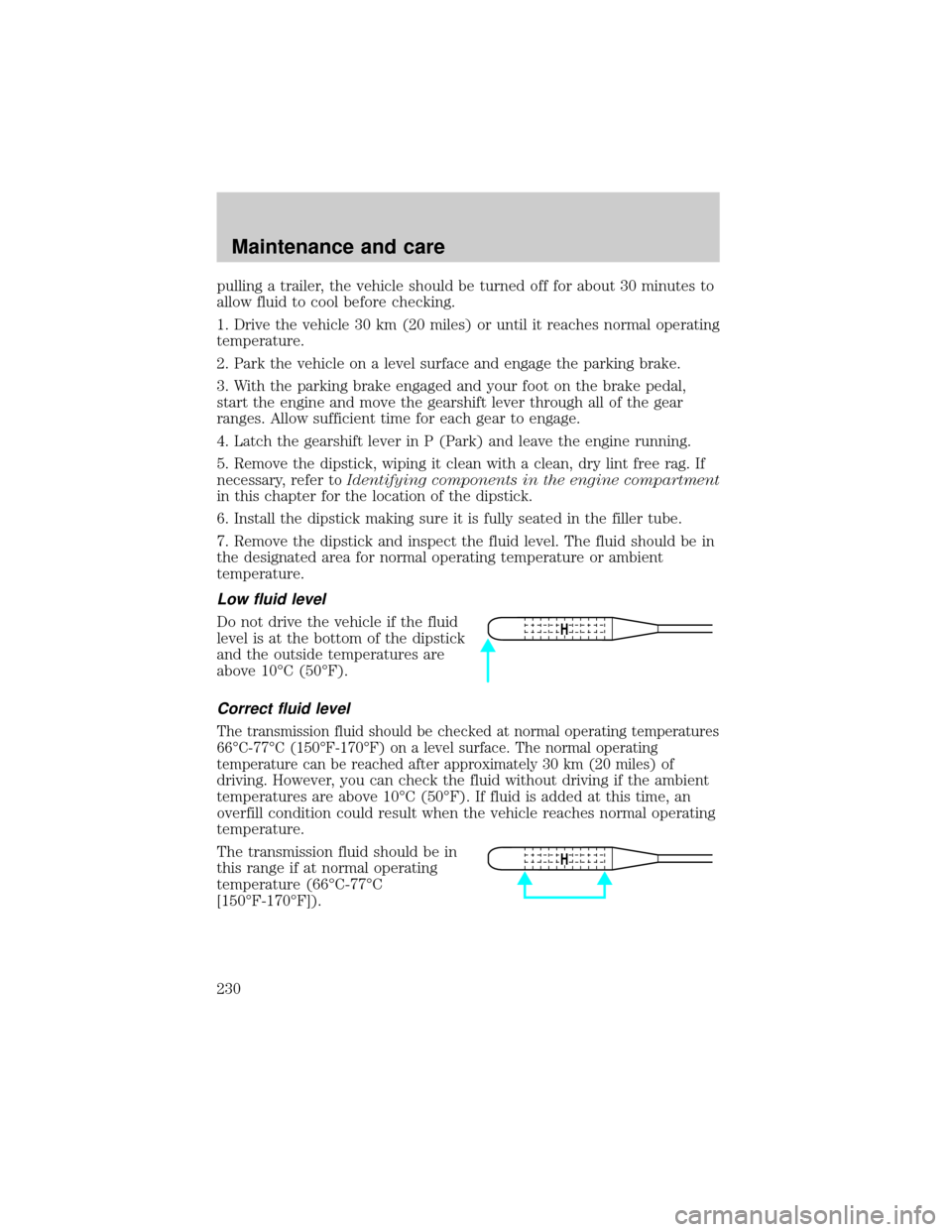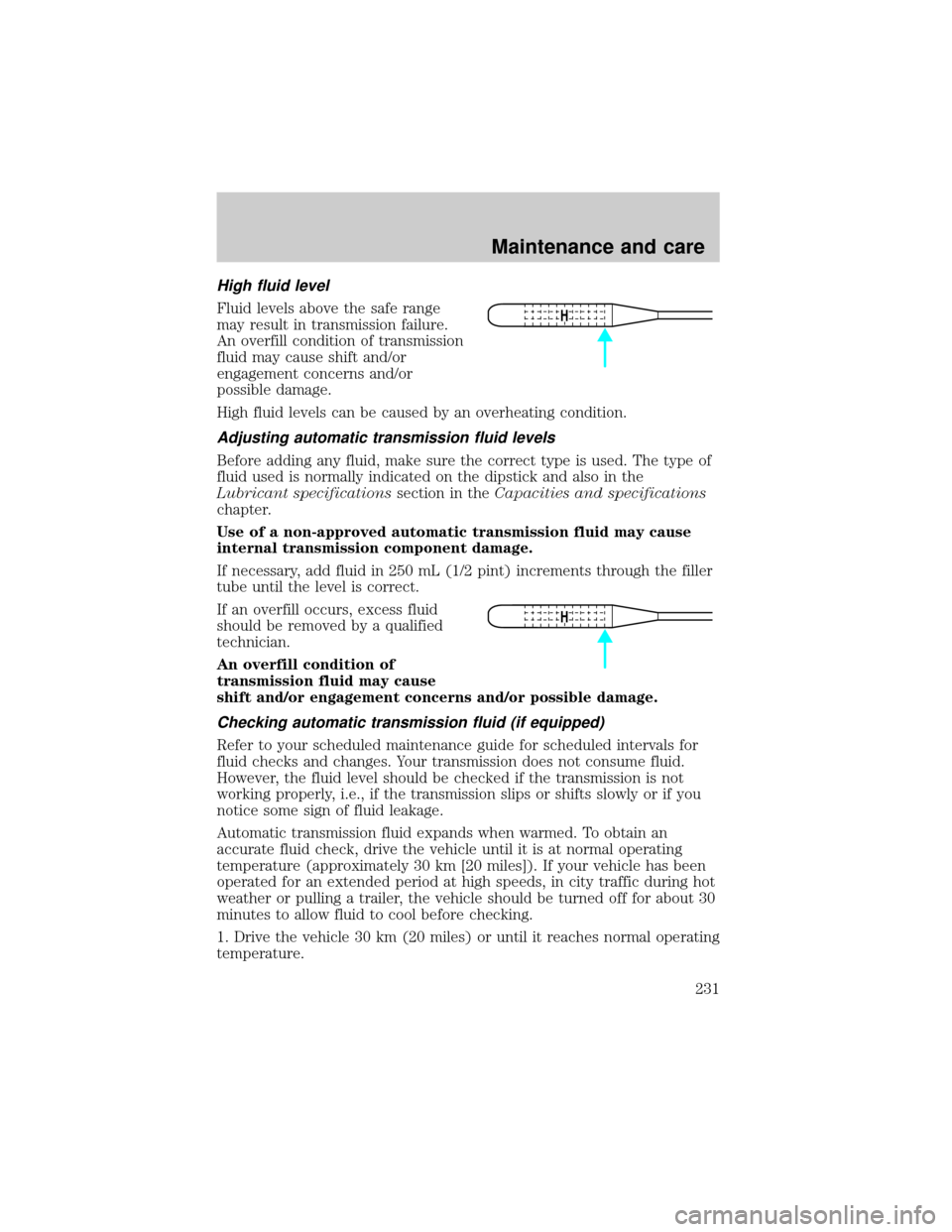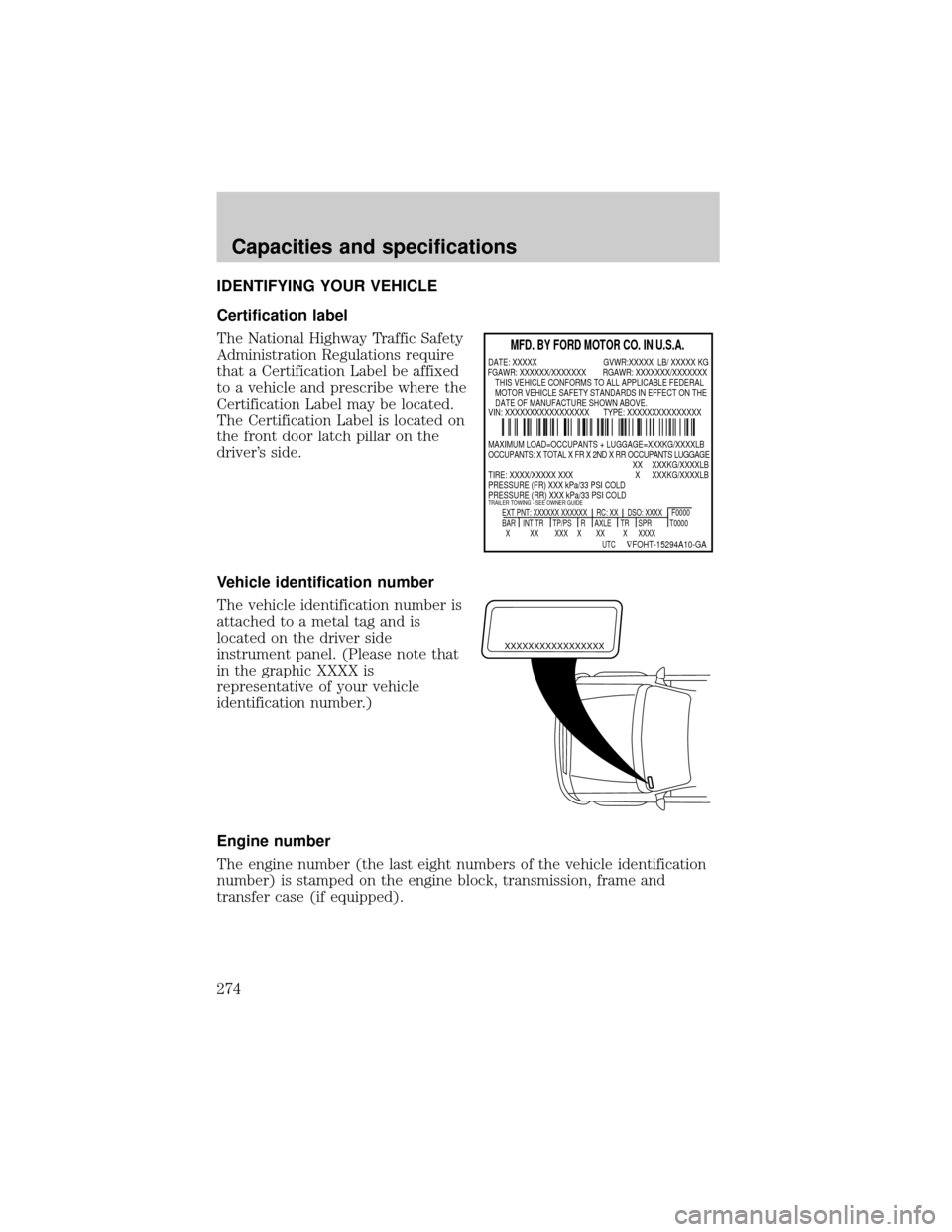2000 FORD EXPLORER trailer
[x] Cancel search: trailerPage 230 of 296

pulling a trailer, the vehicle should be turned off for about 30 minutes to
allow fluid to cool before checking.
1. Drive the vehicle 30 km (20 miles) or until it reaches normal operating
temperature.
2. Park the vehicle on a level surface and engage the parking brake.
3. With the parking brake engaged and your foot on the brake pedal,
start the engine and move the gearshift lever through all of the gear
ranges. Allow sufficient time for each gear to engage.
4. Latch the gearshift lever in P (Park) and leave the engine running.
5. Remove the dipstick, wiping it clean with a clean, dry lint free rag. If
necessary, refer toIdentifying components in the engine compartment
in this chapter for the location of the dipstick.
6. Install the dipstick making sure it is fully seated in the filler tube.
7. Remove the dipstick and inspect the fluid level. The fluid should be in
the designated area for normal operating temperature or ambient
temperature.
Low fluid level
Do not drive the vehicle if the fluid
level is at the bottom of the dipstick
and the outside temperatures are
above 10ÉC (50ÉF).
Correct fluid level
The transmission fluid should be checked at normal operating temperatures
66ÉC-77ÉC (150ÉF-170ÉF) on a level surface. The normal operating
temperature can be reached after approximately 30 km (20 miles) of
driving. However, you can check the fluid without driving if the ambient
temperatures are above 10ÉC (50ÉF). If fluid is added at this time, an
overfill condition could result when the vehicle reaches normal operating
temperature.
The transmission fluid should be in
this range if at normal operating
temperature (66ÉC-77ÉC
[150ÉF-170ÉF]).
H
H
Maintenance and care
230
Page 231 of 296

High fluid level
Fluid levels above the safe range
may result in transmission failure.
An overfill condition of transmission
fluid may cause shift and/or
engagement concerns and/or
possible damage.
High fluid levels can be caused by an overheating condition.
Adjusting automatic transmission fluid levels
Before adding any fluid, make sure the correct type is used. The type of
fluid used is normally indicated on the dipstick and also in the
Lubricant specificationssection in theCapacities and specifications
chapter.
Use of a non-approved automatic transmission fluid may cause
internal transmission component damage.
If necessary, add fluid in 250 mL (1/2 pint) increments through the filler
tube until the level is correct.
If an overfill occurs, excess fluid
should be removed by a qualified
technician.
An overfill condition of
transmission fluid may cause
shift and/or engagement concerns and/or possible damage.
Checking automatic transmission fluid (if equipped)
Refer to your scheduled maintenance guide for scheduled intervals for
fluid checks and changes. Your transmission does not consume fluid.
However, the fluid level should be checked if the transmission is not
working properly, i.e., if the transmission slips or shifts slowly or if you
notice some sign of fluid leakage.
Automatic transmission fluid expands when warmed. To obtain an
accurate fluid check, drive the vehicle until it is at normal operating
temperature (approximately 30 km [20 miles]). If your vehicle has been
operated for an extended period at high speeds, in city traffic during hot
weather or pulling a trailer, the vehicle should be turned off for about 30
minutes to allow fluid to cool before checking.
1. Drive the vehicle 30 km (20 miles) or until it reaches normal operating
temperature.
H
H
Maintenance and care
231
Page 251 of 296

Maintenance
²Keep tires properly inflated and use only recommended size.
²Operating a vehicle with the wheels out of alignment will reduce fuel
economy.
²Use recommended engine oil. Refer toLubricant Specifications.
²Perform all regularly scheduled maintenance items. Follow the
recommended maintenance schedule and owner maintenance checks
found in your vehicle scheduled maintenance guide.
Conditions
²Heavily loading a vehicle or towing a trailer may reduce fuel economy
at any speed.
²Carrying unnecessary weight may reduce fuel economy (approximately
0.4 km/L [1 mpg] is lost for every 180 kg [400 lb] of weight carried).
²Adding certain accessories to your vehicle (for example bug
deflectors, rollbars/light bars, running boards, ski/luggage racks) may
reduce fuel economy.
²Using fuel blended with alcohol may lower fuel economy.
²Fuel economy may decrease with lower temperatures during the first
12±16 km (8±10 miles) of driving.
²Driving on flat terrain offers improved fuel economy as compared to
driving on hilly terrain.
²Transmissions give their best fuel economy when operated in the top
cruise gear and with steady pressure on the gas pedal.
²Four-wheel-drive operation (if equipped) is less fuel efficient than
two-wheel-drive operation.
²Close windows for high speed driving.
EPA window sticker
Every new vehicle should have the EPA window sticker. Contact your
dealer if the window sticker is not supplied with your vehicle. The EPA
window sticker should be your guide for the fuel economy comparisons
with other vehicles.
It is important to note the box in the lower left corner of the window
sticker. These numbers represent the Range of L/100 km (MPG)
expected on the vehicle under optimum conditions. Your fuel economy
may vary depending upon the method of operation and conditions.
Maintenance and care
251
Page 274 of 296

IDENTIFYING YOUR VEHICLE
Certification label
The National Highway Traffic Safety
Administration Regulations require
that a Certification Label be affixed
to a vehicle and prescribe where the
Certification Label may be located.
The Certification Label is located on
the front door latch pillar on the
driver's side.
Vehicle identification number
The vehicle identification number is
attached to a metal tag and is
located on the driver side
instrument panel. (Please note that
in the graphic XXXX is
representative of your vehicle
identification number.)
Engine number
The engine number (the last eight numbers of the vehicle identification
number) is stamped on the engine block, transmission, frame and
transfer case (if equipped).
MFD. BY FORD MOTOR CO. IN U.S.A.
EXT PNT: XXXXXX XXXXXX RC: XX DSO: XXXX F0000
BAR INT TR TP/PS R AXLE TR SPR T0000
X XX XXX X XX X XXXX
UTC
ÑFOHT-15294A10-GA
MAXIMUM LOAD=OCCUPANTS + LUGGAGE=XXXKG/XXXXLB
OCCUPANTS: X TOTAL X FR X 2ND X RR OCCUPANTS LUGGAGE
XX XXXKG/XXXXLB
TIRE: XXXX/XXXXX XXX X XXXKG/XXXXLB
PRESSURE (FR) XXX kPa/33 PSI COLD
PRESSURE (RR) XXX kPa/33 PSI COLD
TRAILER TOWING - SEE OWNER GUIDE
DATE: XXXXX GVWR:XXXXX LB/ XXXXX KG
VIN: XXXXXXXXXXXXXXXXX TYPE: XXXXXXXXXXXXXXX FGAWR: XXXXXX/XXXXXXX RGAWR: XXXXXXX/XXXXXXX
THIS VEHICLE CONFORMS TO ALL APPLICABLE FEDERAL
MOTOR VEHICLE SAFETY STANDARDS IN EFFECT ON THE
DATE OF MANUFACTURE SHOWN ABOVE.
XXXXXXXXXXXXXXXXX
Capacities and specifications
274
Page 284 of 296

Travel equipment
Automatic headlamps with daytime running lights (DRL)
Daytime running lights (DRL)
Factory luggage rack adaptors
Fog lights
Framed luggage covers
Heavy-duty battery
Home link visor
Inside mirror, electrochromic compass (with and without temperature
display)
Luggage/cargo basket
Neutral towing transfer case kit (Explorer 4.0L only)
Removable luggage rack
Removable luggage rack adapters
Running boards
Soft luggage cover
Speed control
Track rider bars (for luggage rack)
Trailer hitch (Class III)
Trailer hitch bars and balls
Trailer hitch mount bike carrier
Trailer hitch wiring adaptor
Trailer lamp wiring
Protection and appearance equipment
Air bag anti-theft locks
Car/truck covers
Cargo liners, interior
Carpet floor mats
Cleaners, waxes and polishes
Door edge guards
Customer assistance
284
Page 292 of 296

fog lamps ...................................21
headlamps .................................21
headlamps, flash to pass ..........22
instrument panel, dimming .....22
replacing bulbs ...............253±257
Lane change indicator
(see Turn signal) ........................81
Liftgate ......................................105
Lights, warning and indicator ......8
air bag ........................................10
anti-lock brakes (ABS) ....10, 156
anti-theft ...................................11
brake ..........................................10
charging system ........................11
check coolant ............................11
check engine ...............................8
cruise indicator .........................13
door ajar ....................................12
fuel cap light ...............................9
high beam .................................11
overdrive off ..............................12
safety belt .................................10
speed control ............................86
turn signal indicator .................11
Load limits .................................176
GAWR ......................................176
GVWR ......................................176
trailer towing ..........................176
Loading instructions .................178
Locks
autolock ...................................114
childproof ................................102
Lubricant specifications ...269, 272
Lumbar support, seats .....122±123
M
Manual transmission .................166
fluid capacities ........................266lubricant specifications ..........272
reverse .....................................168
Message center ...........................17
english/metric button ...............17
reset button ..............................18
system check button ................19
Mirrors
automatic dimming
rearview mirror .......................100
cleaning ...................................265
fold away .................................103
heated ......................................103
side view mirrors (power) .....102
Moon roof ....................................91
Motorcraft parts ................248, 266
O
Octane rating ............................246
Odometer .....................................15
Off-Road Driving .......................174
Oil (see Engine oil) ..................217
P
Panic alarm feature, remote
entry system ..............................108
Parking brake ............................156
Parts (see Motorcraft parts) ....266
Power distribution box
(see Fuses) ...............................196
Power door locks ......................101
Power steering ..........................157
fluid, checking and adding ....228
fluid, refill capacity ................266
fluid, specifications .........269, 272
Index
292
Page 293 of 296

Preparing to drive
your vehicle ...............................158
R
Radio ............................................35
Relays ........................................191
Remote entry system .......107±108
illuminated entry ....................112
locking/unlocking doors .........108
panic alarm .............................108
replacement/additional
transmitters .............................111
replacing the batteries ...........110
Reverse sensing system .............33
Roof rack ...................................188
S
Safety belts (see Safety
restraints) ....................13, 125±130
Safety defects, reporting ..........287
Safety restraints ................125±130
belt minder .............................131
cleaning the safety belts .......135,
264
extension assembly ................130
for adults .........................126±129
for children .............................143
warning light and
chime ...................10, 13, 130±131
Safety seats for children ..........144
Seat belts (see Safety
restraints) ..................................125
Seats ..........................................119
child safety seats ....................144
cleaning ...........................263±264
memory seat ...................109, 122SecuriLock passive
anti-theft system ...............116±117
Servicing your vehicle ..............212
Snowplowing .................................3
Spark plugs, specifications ......266,
272
Special notice ................................3
ambulance conversions ..............3
utility-type vehicles ....................3
Specification chart,
lubricants ...........................269, 272
Speed control ..............................82
Speedometer ...............................14
Starting your vehicle ........150, 152
jump starting ..........................204
Steering wheel
controls ......................................89
tilting .........................................87
T
Tachometer .................................15
Tires ...........................199, 239±241
changing ..........................199±200
checking the pressure ............241
replacing ..................................242
rotating ....................................241
snow tires and chains ............243
tire grades ...............................240
treadwear ................................240
Towing ...............................179, 241
recreational towing .................187
trailer towing ..........................179
wrecker ....................................211
Traction-lok rear axle ...............176
Transfer case
fluid checking .........................235
Index
293